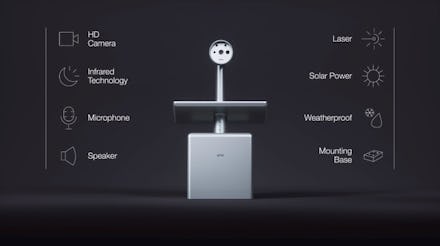A new app lets you send messages to your deceased loved ones

Coronavirus has changed the way we grieve by restricting the size of gatherings and, at times, keeping vulnerable family members at home, away from hospitals and graveside services. It can be difficult to properly manage grief this way, and a new service called AFTR hopes to create a way for families to feel closer to their loved ones when they can't be physically present.
AFTR is the techie solution to long-distance grieving. Using a solar-powered camera, it provides a 24/7 livestream of your loved one's grave. A microphone attached to the camera lets viewers hear the ambient sounds around the headstone, and a speaker allows mourner to discreetly speak or pray to the grave.
As well-intentioned as it is, there's still something slightly Orwellian about the service that might feel unnerving to some. The cold design of the camera doesn't help alleviate that image much, either.
But, if used properly, it could bring comfort to those struggling to handle their grief during these difficult times. The company proposes using their product for family and friends who live too far away to visit, are physically unable to make trips, or cannot pray in person due to bad weather.
The app also features streaming music from Spotify, and a diary where you can jot down memories. Additional messaging services are available for folks who want to leave messages on special dates.
"We increase accessibility with the aid of technology," the company's website says. "AFTR was created to help people to overcome physical obstacles to grieving and to feel eternally connected to their loved ones."
This connection, however, comes at a fairly hefty cost. The ground and gravestone-mounted camera each costs about $500 and the app services can run around $5 or $13 a month, depending on the subscription plan.
The price and gadgets may seem like a lot, but we really shouldn't be surprised to see technology used this way. People have expressed their grief in myriad ways, including remembering the dead by turning their ashes into jewelry, composting bodies or turning them into plants, pressing remains into stones, and the very modern-day means of preserving a deceased person's social media posts.
As technology advances, more of these sorts of solutions are bound to come and go. It'll be interesting to see what future cemeteries look like, and how many cameras will be involved.